Wobbly kitten is steadfast lover of life
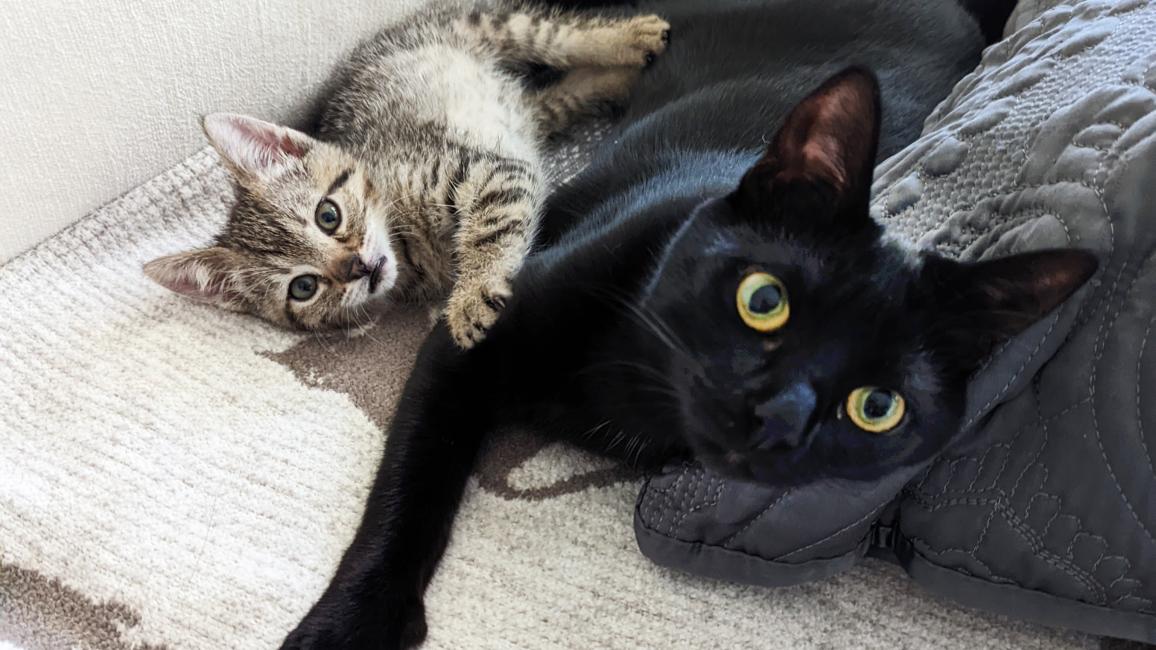
“Hey Krystal, I think we’ve got a wobbly kitten.”
A group of staff and medical team members are gathered in the nursery, observing five newly arrived kittens. Krystal Vera, Best Friends supervisor of lifesaving and care in Los Angeles, has an experienced eye when it comes to spotting wobbly kittens, and so she pops into the nursery for a peek. In the scrum of kittens at the back of the kennel is a kitten named Harlie Q., and Krystal immediately spots her unmistakably different gait. “Oh yeah, that’s her,” she says.
“Hi, baby,” says Krystal, and the tiny, all-black kitten at the back instantly responds, wobbling through the fuzzy crowd toward her voice.
It’s just before feeding time and Krystal watches as the food arrives and kittens try to push each other out of the way. Though Harlie Q. is smaller, she stands her ground. She won’t be intimidated off her dinner or, later, pushed out of games. When the other kittens play, she’s right in the middle of it.
In so many ways, Harlie Q. is just like any other kitten with a big personality. The only difference is that she has cerebellar hypoplasia (CH), a neurological condition that occurs when a pregnant cat has a viral infection. That infection can halt the development of her kittens’ cerebellum, a part of the brain that governs motor function and balance. CH may cause kittens to have tremors, sway or wobble when they walk, overstep or have an abnormal gait. And since CH can be mild to severe, cats with the condition may walk like they’re a little tipsy, or they may not be able to stand up at all.
As for Harlie Q., Krystal could see that her condition was mild to moderate. This meant that, with some home modifications that make it easy to navigate and otherwise safe for a cat with CH, Harlie Q. could live just as long and happy a life as a cat without the condition.
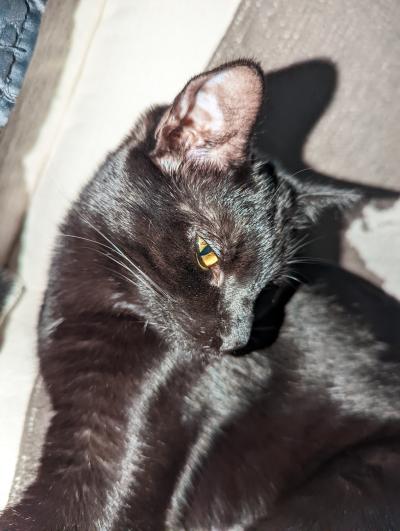
Choosing to foster a cat with CH is easy math
Harlie Q. was brought to Best Friends from a Los Angeles Animal Services shelter and spent her first months in the nursery. Then, just as she and her kitten cohort were about to be transferred to the big cat area, they came down with a respiratory infection. So, they were transferred to “preschool,” an area at the lifesaving center where kittens and cats needing medical care before adoption can be observed by the medical team, staff and volunteers.
That’s where Harlie Q. caught the eye of longtime Best Friends volunteer Katherine Hayes. Katherine is a fan of cats needing a little extra love and care, which is why she loves volunteering with cats in preschool. Kane, one of the first cats she ever fostered, had a congenital defect in his spine and ankles.
[Wobbly kitten gets by with help from his friends]
Katherine recently lost Savannah, her senior cat with special needs — a big, white, fluffy, green-eyed love she adopted from Best Friends in 2015. After Savannah, it was just Katherine and Allie, her senior cat companion of 18 years. With Savannah gone and feeling an absence in the house, Katherine dove into fostering cats she met at preschool.
Katherine had learned about CH through discussions with Krystal about her cat, Ornn, who has a severe case of CH. Katherine met Ornn as a kitten and watched him grow into Krystal’s best friend and traveling companion. She adored him. And she saw what was possible for other cats with CH through understanding and the right care. It was Ornn who made Katherine want to foster a cat with CH.
Harlie Q. caught Katherine’s eye immediately. She was all black, just like Allie, petite but bursting with personality, and she had CH. It was easy math: Katherine, who had already fostered eight kittens from Best Friends, decided to foster Harlie Q. in her home.
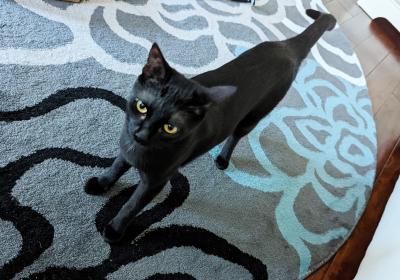
One kitten with CH + another = cutest dream team
Katherine had Harlie Q. in her charge longer than most kittens in foster care because the vet recommended that she be a bit more mature before she was spayed (normal guideline for cats is two months old or weighing two pounds). It would be safer, they decided, if she weighed four pounds.
By the time Harlie Q. reached four pounds, Katherine, who always falls in love with her foster cats, was already head over heels. During the extra time together, she realized her joy in watching Harlie Q. grow and learn how to navigate the three-story townhome’s stairs, how to remain steady in the litter box and live her life. She couldn’t let her go, and so, she didn’t. She adopted Harlie Q.
When it became clear that her new houseguest needed someone to play with, she fostered Nicholas, another kitten with CH. They formed the cutest dream team. She couldn’t let go of Nicholas, either, so she adopted him, too.
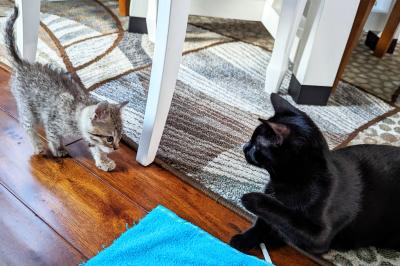
A change in perspective
One thing Katherine has learned from Harlie Q. and Nicholas is that, for them, life on unsteady paws is normal. They’re just as determined to play, eat, snuggle and snooze as any other cat. Of course, there are adjustments.
Since their heads shake, Katherine uses an elevated food station so that hungry heads stay level at mealtimes. When she picks them up for a hug, she makes sure to put them down with all four paws planted firmly on the ground to avoid falls. A high wall litter box helps keep them steady. And a good broom helps her clean up litter raked from the box.
While she doesn’t use a laser light for games (since Harlie Q. and Nicholas are too unsteady and could fall chasing the light), Katherine keeps them entertained with a cat mobile, boxes, balls, a tunnel and toys. (Harlie Q. loves to cart Lambchop, her stuffed toy, around in her mouth.)
Harlie Q. isn’t comfortable being up high because jumping up and down can be difficult. The couch is as high as she goes. So, Katherine constructs little forts and cat beds in places where she can access them.
[Two special cats with mobility challenges go home together]
Alert and responsive, Harlie Q. reacts with a start when Katherine or Nicholas enters the room. Sometimes she reminds Katherine of a little sentry, always on the lookout. But mostly she reminds Katherine of Winnie the Pooh’s small, anxious (but also brave and bighearted) friend, Piglet.
When Katherine gets out of bed in the morning, Harlie Q. flops at her feet, stretches out and squeaks good morning. Returning from work, Harlie Q. is there, along with Nicolas, and she receives the same sweet greeting. She’s a loving companion whose rocking-horse-in-mid-air run makes her laugh, and whose determination to live life to the fullest brings her joy.
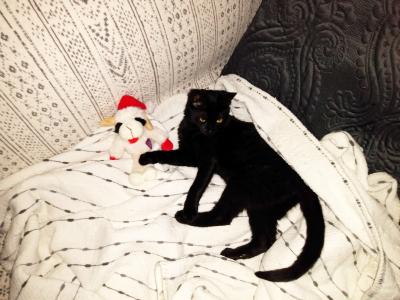
More awareness = more happy stories of cats with CH
Krystal believes is that obstacles to adopting cats with CH will lessen if more people are informed about the condition. She makes sure to counsel potential adopters and give them all the information and support needed for the right care. As more and more people foster cats with CH, Krystal learns more about the personalities and symptoms of each cat. And just as it would for any other cat, the information helps her find an adoption match.
As more veterinarians, organizations and people learn about CH, Krystal is hearing even more happy stories of lives being changed for the better. For example, one woman who adopted a cat with CH regularly visits Best Friends to thank her personally, because caring for her cat has been such a profound gift to her life.
Cats with CH (either mild or severe) “are perfectly imperfect — the best,” says Katherine. Her story of adopting Harlie Q. and Nicholas is just more proof.
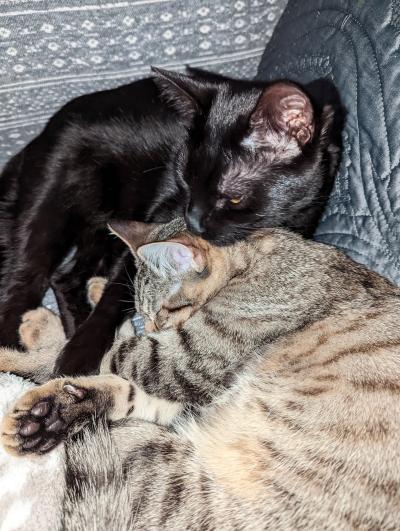
Adopt and help save lives
Visit your local shelter or rescue group to meet a cat (or dog) like Harlie Q. who would love to be a part of your family.
Read more
A tiny but mighty kitten fights panleukopenia
Senior cat with cerebellar hypoplasia gets another chance at happily-ever-after
This cat might be a bit wobbly, but her mom doesn’t mind one bit